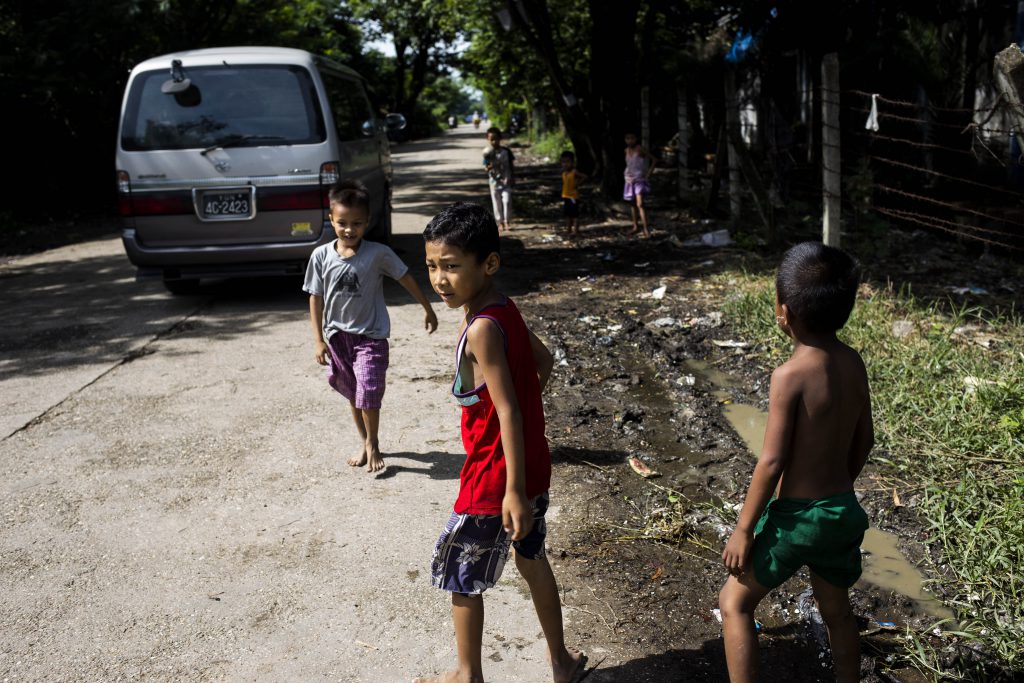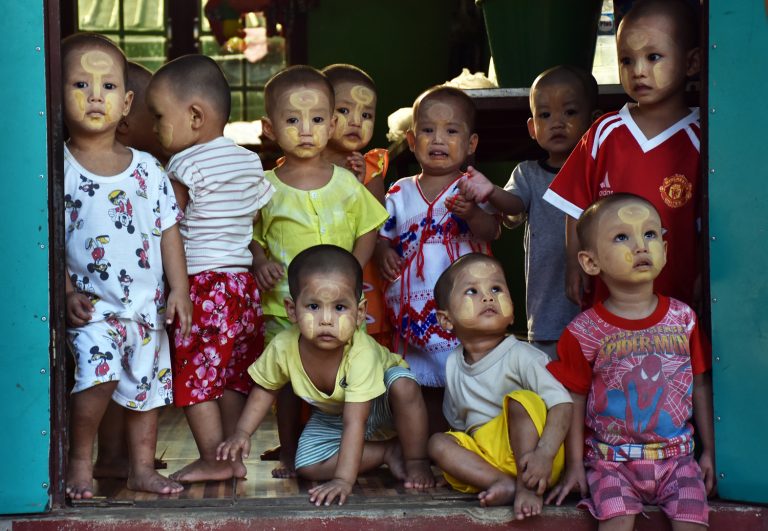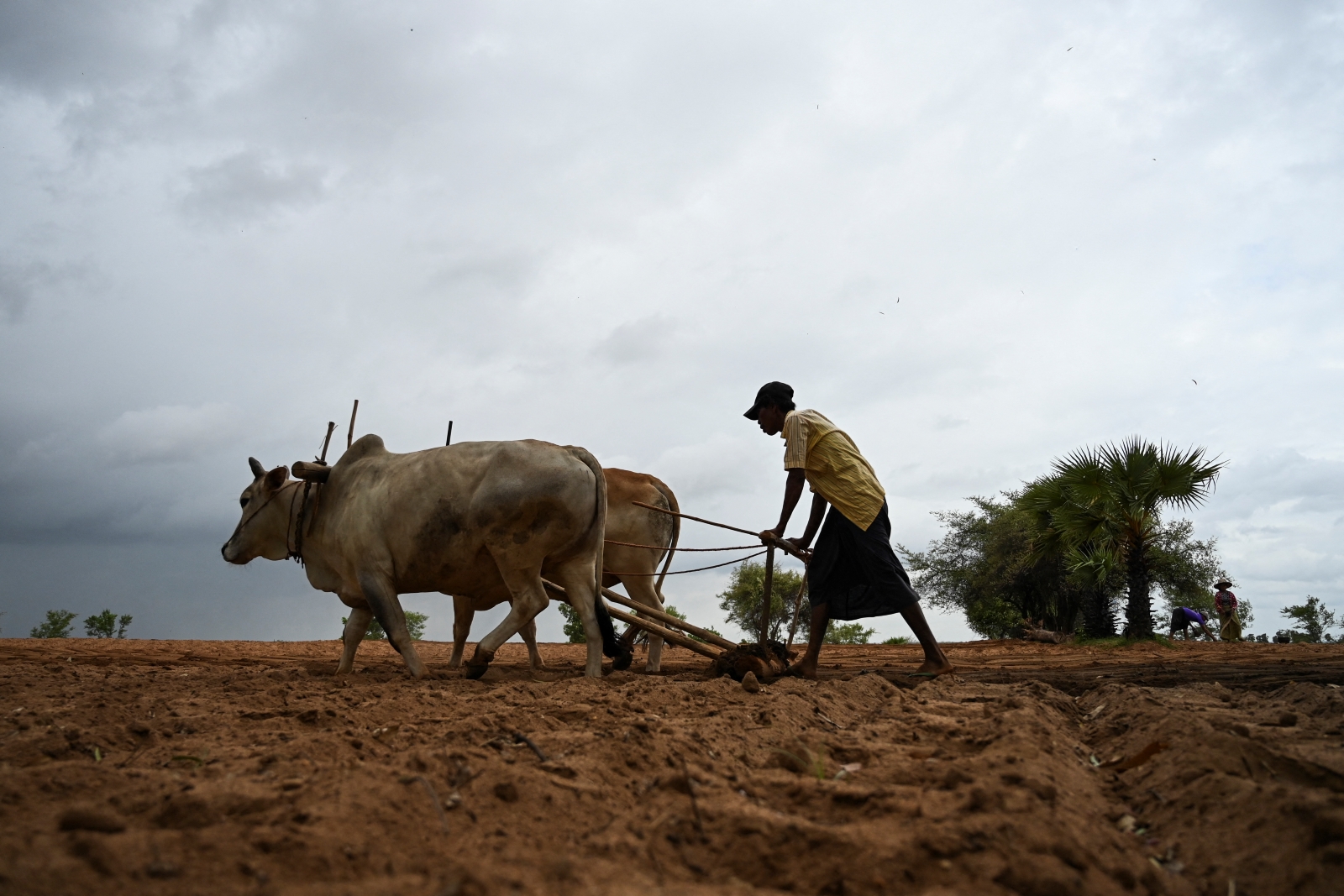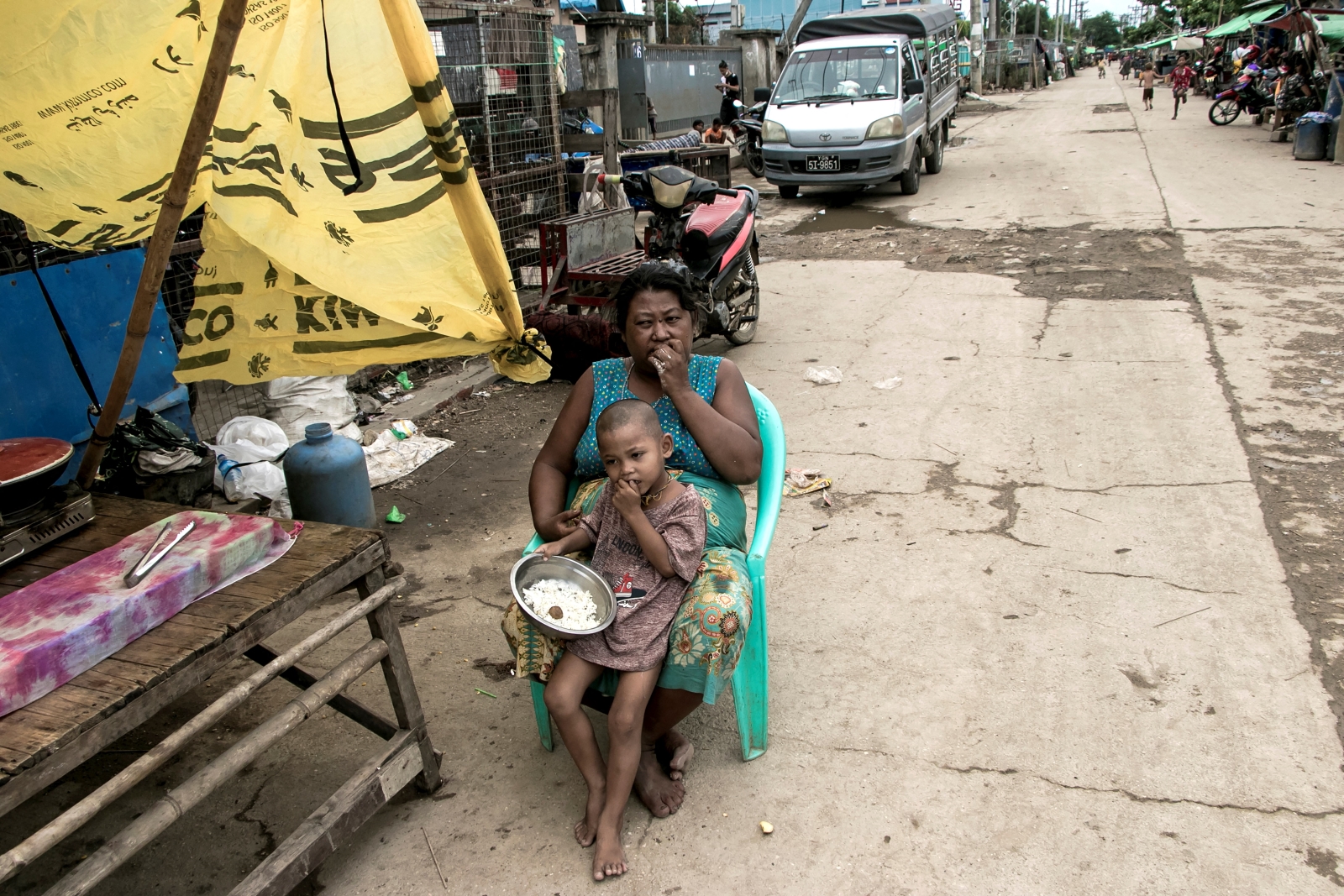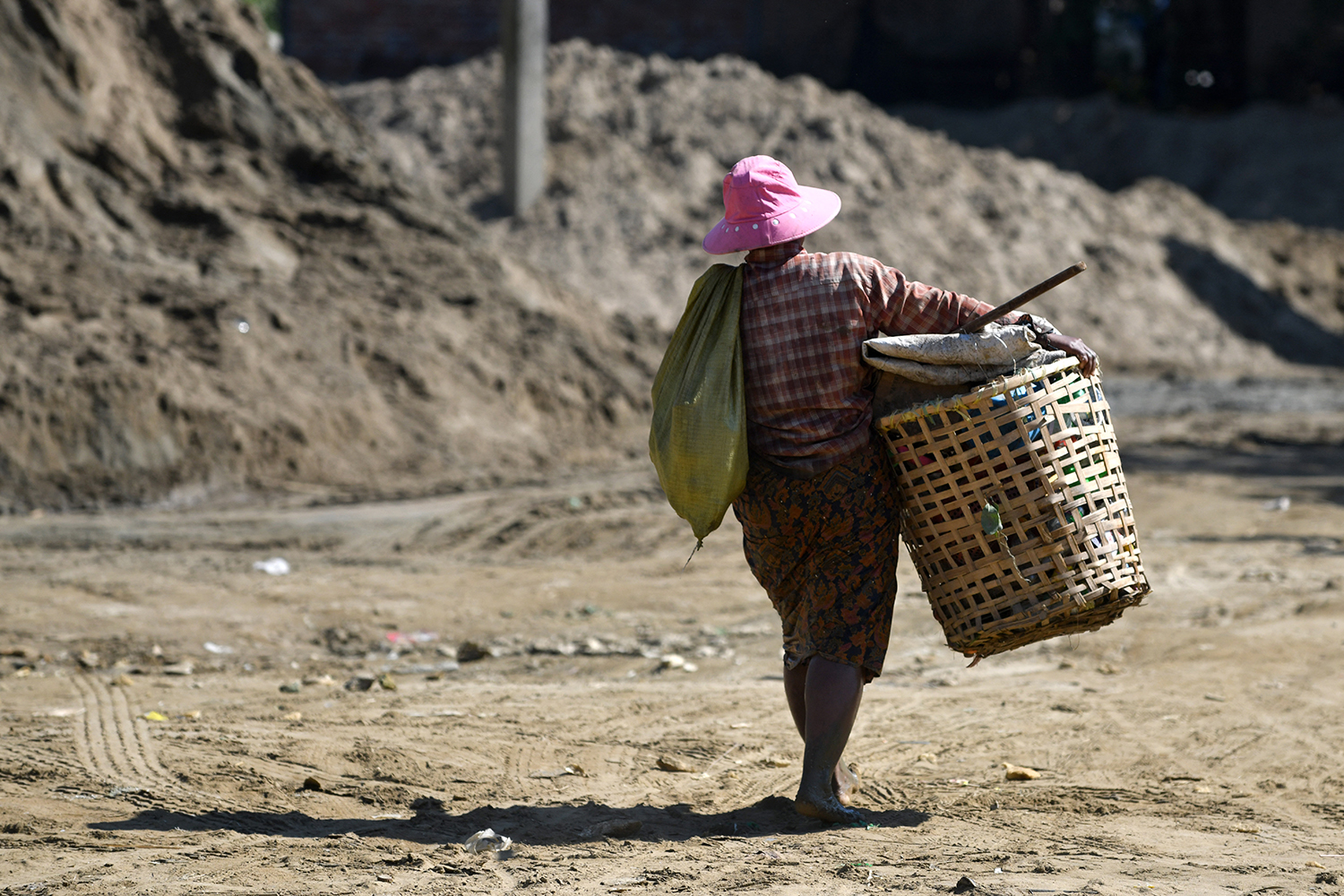People moving from rural areas to find factory jobs on Yangon’s outskirts are likely to be disappointed, a recent study has found.
By GEOFFREY GODDARD & MRATT KYAW THU | FRONTIER
Photos ANN WANG
Ma Chit Su dreamed of finding a job at a factory in the industrial zone at Hlaing Tharyar Township on Yangon’s western outskirts.
When she moved from her village in Mawkun Township in Ayeryarwady Region six years ago her dream was shattered. At 29 she was too old. Factory employees must be aged between 18 and 25 and in good health.
“I didn’t know there were no jobs for anyone over 25,” Ma Chit Su said. “I had to find casual work, such as washing clothes, cleaning houses or selling bottles of water,” she said. “My dream ended.”
Her husband, now 38, was also too old for a factory job and does building work as a day labourer to support the family, which has two boys, aged five and three.
Ma Yin Mon Soe, 23, was luckier. She left Bogale Township in Ayeyarwady Region when she was 17 and found work in a township garment factory, earning about K120,000 a month. Ma Yin Mon Soe had a series of garment factory jobs, sending money home every month to her parents.
Three months ago she had to stop work because of a heart condition. She was feeling better a month ago and began looking for a new job but none were available. “Most of the factories have stopped recruiting; I think it’s because of the introduction of the minimum wage [of K3,600 or around US$3.00 a day]”, she said. Ma Yin Mon Soe has to rely on financial support from her two elder sisters, who work in Malaysia. If jobs were available Ma Yin Mon Soe would be unlikely to fill a vacancy because of her heart condition.
The experiences of Ma Chit Su and Ma Yin Mon Soe are supported by a study which challenges the assumption that squatters living on Yangon’s outskirts easily find jobs in nearby factories.
Few of the squatters in Hlaing Tharyar held regular jobs in any of the hundreds of factories in its industrial zones, found the study by Eben Forbes on informal settlements in and around Yangon.
Hlaing Tharyar has the highest squatter population of the city’s 39 townships, at 16,000, show Yangon City Development Committee figures for 2013. The township’s industrial zones have 838 factories and workshops, the second highest number in Yangon, says the YCDC/Japan International Cooperation Agency Master Plan released in 2013.
“Yet, none of the respondents in this study had a regular factory job, and few even knew of someone in their ward who held such a job,” wrote Mr Forbes, whose research project included interviews with squatters in outer eastern Dagon Seikkan, one of the city’s fastest growing periphery areas, and in Thaketa and Hlaing townships, which are closer to central Yangon.
“In order to control speculation, the government needs to gather precise land ownership data. If it had data on how much land speculators owned, it could investigate them for price manipulation.”
Apart from the age and health stipulations, most squatters lack the minimum educational qualifications for factory jobs.
However, the study found squatters benefit indirectly from living near industrial zones because they provide opportunities to earn income from activities such as selling food to factory workers. Employment was also generated by the informal settlements themselves, such as the sale of goods or services to other squatters or in neighbourhood markets.
The limited job opportunities for squatters in industrial zones means that that those who find employment in the inner city must endure long commutes, which are a burden in time and money. It is a burden exacerbated by the city’s outdated bus system. The study quoted research by the Seoul Institute that found the average speed of inner city buses is 0.5 miles an hour (0.8km/h) faster than walking.
Squatting communities on the plains around the city are prone to flooding during the rainy season. Crowded conditions and the use of flammable building materials, such as palm thatch roofs, and wood for cooking makes them a fire risk during the dry season.
Mr Forbes, 46, conducted the study, On the Frontier of Urbanization: Informal Settlements in Yangon, as a visiting fellow of the Rajawali Foundation Institute for Asia at the Ash Center for Democratic Governance and Innovation, Harvard Kennedy School, in the United States.
Information for the study was collected during a visit to Yangon by Mr Forbes between December 2014 and February 2015.
As well as Hlaing Tharyar and Dagon Seikkan, interviews were conducted with squatters in Thaketa and Hlaing townships, which are between the city centre and its outskirts.
The criteria for choosing “informal settlement” areas for the study were that most residents were squatters from poor or low-income households who had no legal claim to their land or housing and usually lacked access to basic services, such as water, sewerage, electricity and garbage disposal. All squatters face the threat of eviction.
Most squatters live in substandard housing with more than five family members to a single room, compared to the Yangon average of 4.4 members to a household. A squatter family’s hut typically measures 15 feet by 20 feet (about 5.4 metres by 7.2m) and conditions in the settlements “may be visibly squalid with open garbage dumps and inadequate latrines resulting it foul odours”.
The study was informed by insights that Mr Forbes, an American, acquired during the previous four years as a program officer at UN Habitat in Yangon. He was also motivated by a desire to help fill “a profound knowledge gap” in urban studies in Myanmar.
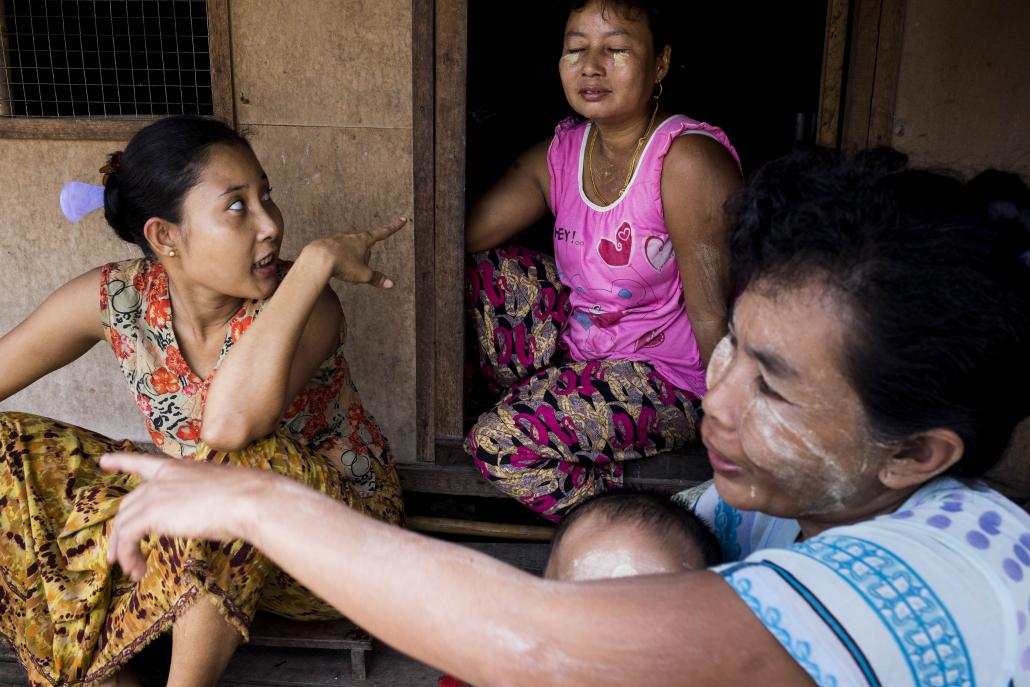
Ma Thi Thi Lwin, left, 31, moved to Hlaing Tharyar six years ago from Bogale Township in Ayeyarwady Region. She was unable to get a factory job because she lacked the minimum educational qualifications. (Ann Wang / Frontier)
The study found marked differences between the outer Yangon townships and two that are closer to the city centre: Thaketa, across the Pazundaung Creek east of the city centre, and Hlaing, between the Hlaing River and Inya Lake.
One of the most significant differences was a noticeable sense of communal unity in Thaketa compared with the three other townships. This was partly attributed to most squatters in Thaketa being from other parts of the township, a low threat of eviction and longer-term residence, averaging eight-and-a-half years.
“Elsewhere this threat is capable of creating divisions where longer-term squatters feel they have more rights than recent arrivals,” the study said.
Another possible reason for community affinity in Thaketa was incomes being “more or less equal”. There was greater variation in incomes in squatter settlements on the outskirts, where community leaders had a financial advantage because of the profits from informal real estate transactions. In Hlaing Tharyar and Dagon Seikkan owners of wells and generators had a monopoly over water for washing and the supply of electricity, respectively, enabling them to generate more wealth than their neighbours.
Access to water pirated from municipal supply made a difference to the lives of squatters in Thaketa and Hlaing. This was in marked contrast to Hlaing Tharyar and Dagon Seikkan where most squatters had to rely on two water delivery services that added to living costs. The daily cost of big drinking water containers is between K200 and K400 a day and washing water in barrels costs from K400 to K600.
The cost of water for households in formal communities is cheaper than that in informal communities in peripheral areas because it has to be transported in containers. Apart from being inefficient, this adds transport costs to the cost of the water bought by squatters.
Because of the need for more studies before definitive recommendations can be made, those offered by Mr Forbes were tentative.
“In any case there are no easy answers, as this terrain is full of unintended consequences,” he said.
The 13 tentative recommendations included the need for the authorities to be aware of squatters’ logic that the decision to squat is usually a rational choice, such as the result of rising rents.
“Understanding their logic can help authorities to work with squatters rather than against them, in the search for solutions,” he said.
Mr Forbes said the government should work with community-based organisations. As well as being more trusted by the communities they represent, they are closer to the community and can better advocate for solutions that benefit residents.
Community-based organisations can also be effective mediators between the government and squatters. They can help squatters to organise, achieve a consensus among themselves and ultimately enable them to have a voice that is heard by government.
Another proposal focussed on mapping. If a community can, through mapping exercises and dialogue, reach internal consensus on spatial planning, it will be in a much stronger position to negotiate with government for future land rights and access to services.
Mr Forbes advocated for evictions to be considered only as a last resort. “Eviction is bad for everyone: traumatic for the residents and also bad for the YCDC’s relations with the public,” he said, adding that evictions only lead to squatting in another location.
He said discussion of evictions should not be limited to the sites occupied by squatters but also the impact on informal businesses, such as vendors’ stalls and tea shops. “Loss of employment should be considered too, not only loss of housing.”
If evictions of families who had been long-term residents of informal settlements were necessary, they should be accompanied with a fair and just compensation package.
The tentative recommendations also included granting amnesties to the few squatters who remain in the city centre and that the upgrading of slums be undertaken carefully. This would “avoid elite capture by slum landlords (informal land- lords) who may simply raise the rent if a slum area is upgraded, which would force the poorest renters to leave,” Mr Forbes said.
“The same risk exists when the bene t of large government investments in infrastructure (which raises land prices), are captured by the private sector through real estate development, and never returned to the community which paid for the investment with their taxes,” he said.
Mr Forbes said prevention was less costly than upgrading or relocating a slum. “The best policy would be one that prevents slums in the first place by addressing root causes, although this is very difficult to accomplish in the short term.” He said policy and planning should focus on those newer peri-urban areas that are under the most pressure for rapid residential development and are due to be subsumed by Yangon’s urban expansion.
The study also proposed that policy makers and planners must review regulatory frameworks and remove or relax constraints on access to a ordable land and housing.
The nal tentative recommendation focussed on the need to control the “rampant” speculation in and around Yangon that was driving up land prices. “Land is still the preferred investment choice of many business people, partly because there are few investment alternatives, such as a stock market,” Mr Forbes said. “In order to control speculation, the government needs to gather precise land ownership data. If it had data on how much land speculators owned, it could investigate them for price manipulation.”
Mr Forbes said continuous change was a challenge for research on urbanisation in Yangon. “When this research study was rst conceived, in October 2013, I assumed I would be able to study slums located in or very close to the central business district,” he said. By the time Mr Forbes began his eld research in late 2014, the inner city slums had nearly all been cleared. “Urbanisation is happening more rapidly in Yangon than ever before,” he said. “The informal settlement areas chosen for this study may no longer exist when and if, this researcher, or another researcher, has the opportunity for follow-up research.”
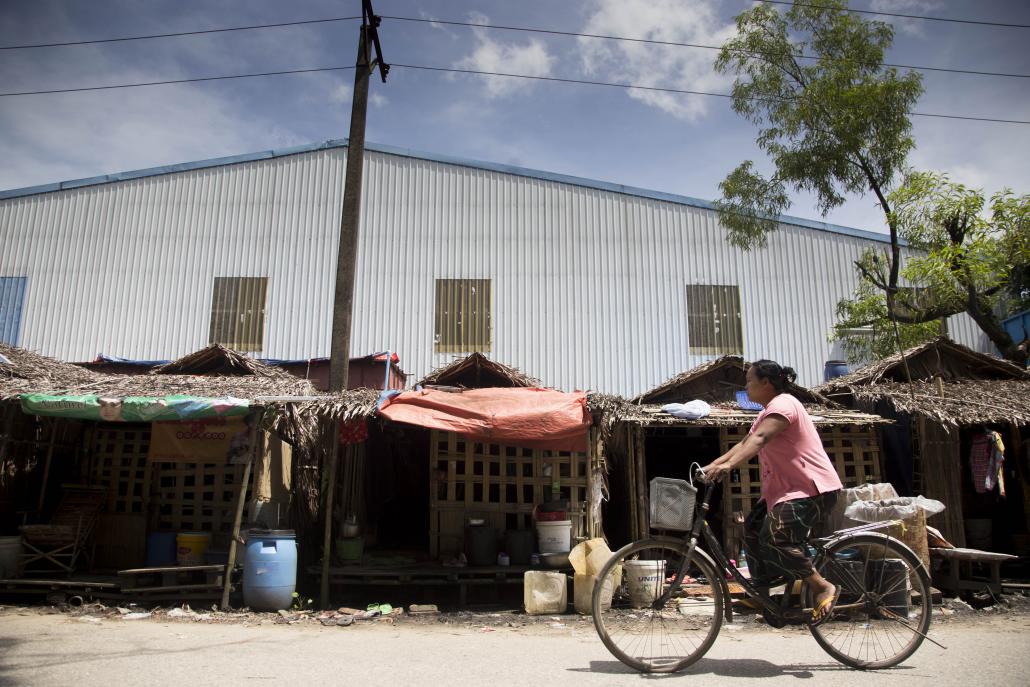
Squat housing in Hlaing Tharyar. (Ann Wang / Frontier)
On the periphery
Hlaing Tharyar is the most populous Yangon township with nearly 500,000 residents and is the fastest growing in both formal and informal settlement populations. It was created in 1993 to house squatters relocated from downtown Yangon but its residents were never given proper access to water and sanitation. Migration from Ayeyarwady Region is mainly responsible for the population growth and it surged after the delta region was devastated by Cyclone Nargis in 2008. Diseases are rife in the township because of poor living conditions and the lack of water and sanitation facilities. A recent informal study by UN Habitat found that Hlaing Tharyar has the highest incidence of diarrhoea of all Yangon townships and is ranked second for malaria and third for dysentery.
Daggon Seikkan has a population of 120,000 and is one of the city’s fastest growing periphery townships. It has the highest proportion of informal settlements to the total township population, at 7.6 percent, show YCDC figures from 2012. Most of the surveyed households were in Ward 67 and all were squatting on YCDC land. Eviction notices were being issued by the Department of Human Settlements and Housing Development to build what it calls “affordable” housing. “Unfortunately, none of the households interviewed will be able to afford a unit of this ‘affordable housing’”, the study said. Surveyed households reported having migrated from rural and urban areas in equal numbers.
Many moved from townships closer to the central business district, including Thaketa, because development had priced them out of the rental market.
Thaketa Township was created when squatters were relocated from the city centre in the late 1950s and 1960s. The relocation programs were relatively well managed, with 30-year and 60-year leases often being given and access to services provided in some places. Decades later, a new generation of squatters is emerging because of increases in living costs and rent. “Many households are being ‘priced out’ of the rental housing market and are ending up as squatters within their native township,” the study said. The sense of community was evident in the way neighbours came to each other’s huts during interviews. Community leaders also helped residents by providing formal addresses so children could sit the matriculation exam and by organising volunteers for street cleaning and drain clearing.
Unlike the other townships chosen for the study, Hlaing was not established for resettlement but is part of the original city of Yangon. Interviews were conducted in a 40-household area on land owned by the Ministry of Education near an abandoned waste-water treatment plant. The area is close to Hlaing station and a Circle Line trip to the CBD takes less than 30 minutes, half the time than by car. Despite this “great transportation option” many of the squatters do laundering or housecleaning work for nearby middle class families. The squatters are evicted every April by the YCDC and flee temporarily, often to Hlaing Tharyar, before returning when it is safe. Their shacks are made of inexpensive materials and can easily be rebuilt. The squatters also face the threat of eviction from non-resident informal landlords if they fall behind with their rent.
Title photo: Boys on the road in Hlaing Tharyar Township. (Ann Wang / Frontier)


